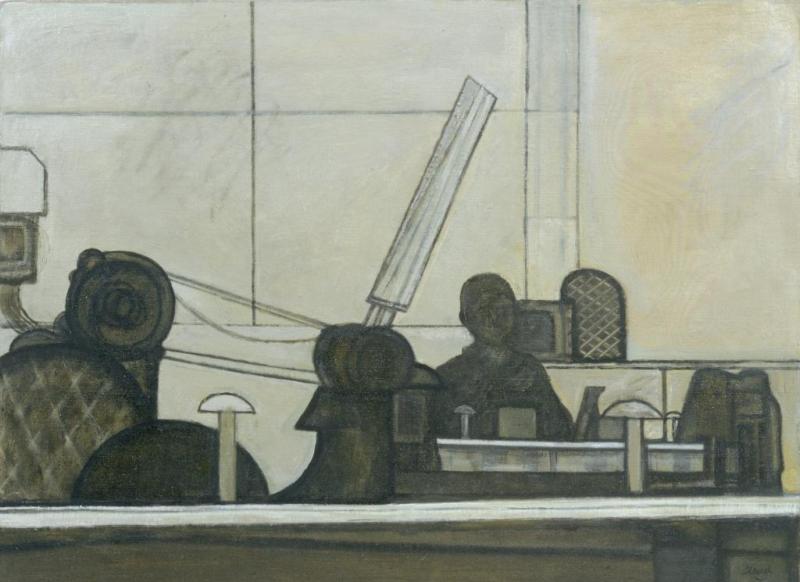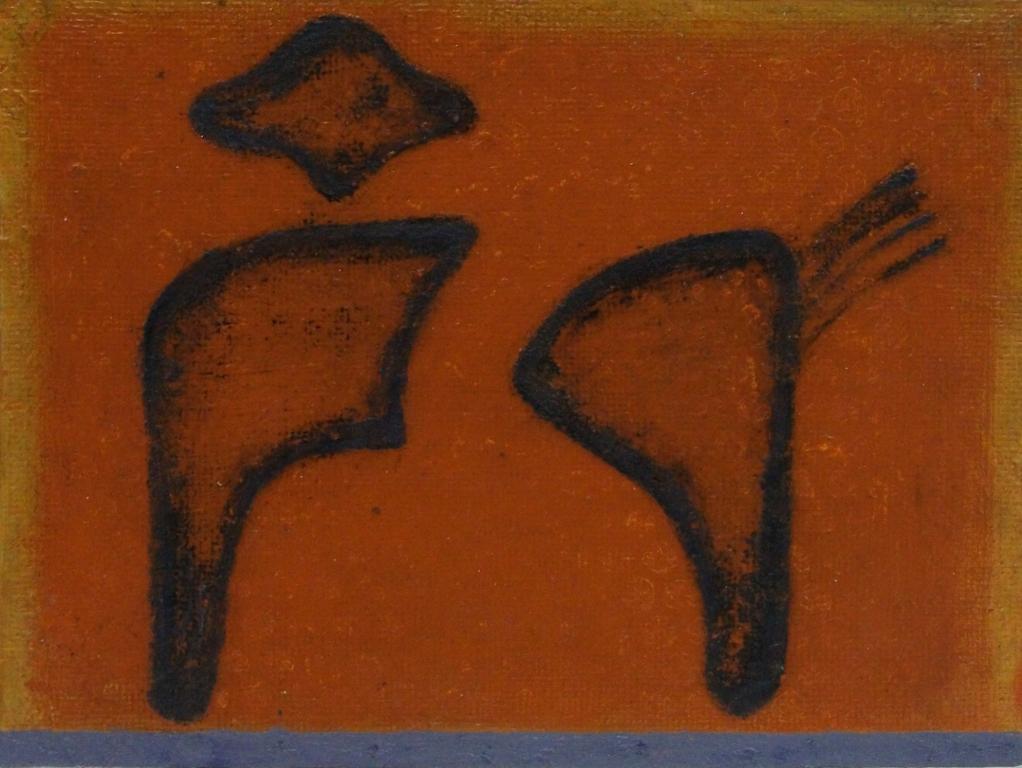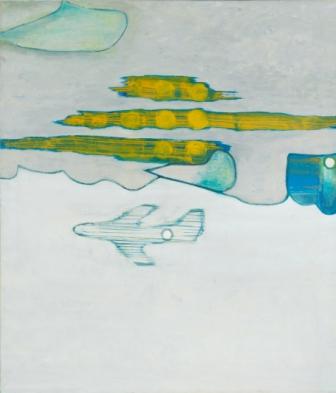Prunella Clough, Annely Juda | reviews, news & interviews
Prunella Clough, Annely Juda
Prunella Clough, Annely Juda
A strange, elusive and haunting overview of an underappreciated postwar original

Prunella Clough, 1919–1999, was one of the most idiosyncratic and original British artists of the postwar period. Her art is reticent, shy, subtle - yet in both life and aesthetics she was a free and generous spirit. Now there is a fine selection of works large and small, but all domestic in size, on view in the West End, marking the publication of a magisterial new biography by Frances Spalding.
Although Clough has been widely exhibited her art remains curiously unknown and unappreciated on a wider scale. Her peer group, including the postwar Neo-Romantics, have been positively scrutinised both critically and commercially. Yet she has remained a footnote, which makes this gentle show of modest works particularly important.
Her paintings here are strange, elusive and haunting. Scraps of forms that are recognisable as landscape, sky, architectural details and plants of all kinds are set free to float in textured fields of dappled, textured colour. They are creative echoes of her more straightforward early work, which were meditations on recognisable if generalised cityscapes and industrial constructions. There are a few from that period in the show, including Man with a Printing Press, and Factory Interior (Wool Carding Shop) in which a range of greys suggest a host of mechanical shapes acting out their own narratives with human help.
 Mostly, though, what is on view is a sequence of paintings, reliefs, drawings and collages dating from the 1970s on when remnants of the recognisable interweave with dream-like gossamer shapes or the solidity of architectural fragments. As her various titles often suggest, her unusual imagination fastened on observed details: leaves, skulls, gateways to cloud formations, mechanical scraps. Widget, oil on board (pictured above), outlines in greys two disparate characters, setting them against subtle oranges to make up a whole whose purpose remains tantalisingly mysterious.
Mostly, though, what is on view is a sequence of paintings, reliefs, drawings and collages dating from the 1970s on when remnants of the recognisable interweave with dream-like gossamer shapes or the solidity of architectural fragments. As her various titles often suggest, her unusual imagination fastened on observed details: leaves, skulls, gateways to cloud formations, mechanical scraps. Widget, oil on board (pictured above), outlines in greys two disparate characters, setting them against subtle oranges to make up a whole whose purpose remains tantalisingly mysterious.
Windswept is a flow of red dots scurrying over denser reds, suggestive of a landscape tossed about by invisible winds. Artificial Flower is an exuberant spray of stems against a gridded background; Succulent, mixed media and collage, is a plump, smug and possibly preening plant shape, an entity that is very well nourished. Her imagery is apparently benign, though with many there is a little frisson of unease. She disarms us to tease us.
 Flight Path (pictured left) is typically Clough: quite a grand little composition in which the blue outline of a plane flies under heaped up cloud banks, mysteriously irradiated by horizontal streaks of yellow, echoing somehow the improbable feeling of being up there in the sky with things that are never visible from below. It contains a hint of exhilaration - and, yes, unease - and of motion and movement paradoxically transfixed.
Flight Path (pictured left) is typically Clough: quite a grand little composition in which the blue outline of a plane flies under heaped up cloud banks, mysteriously irradiated by horizontal streaks of yellow, echoing somehow the improbable feeling of being up there in the sky with things that are never visible from below. It contains a hint of exhilaration - and, yes, unease - and of motion and movement paradoxically transfixed.
Reproductions of Cloughs make everything seem a little flat; in reality the layering of paint, the unexpected collage, the hardly visible texturing of surfaces makes each piece endlessly fascinating, even oddly hypnotic. Each piece seems to contain even more than you see, somehow very politely but firmly insisting that appropriate attention be paid. It is a peculiarly gratifying exhibition, these small and strangely beautiful abstracts packing quite a terrific emotional punch.
rating
Explore topics
Share this article
The future of Arts Journalism
You can stop theartsdesk.com closing!
We urgently need financing to survive. Our fundraising drive has thus far raised £49,000 but we need to reach £100,000 or we will be forced to close. Please contribute here: https://gofund.me/c3f6033d
And if you can forward this information to anyone who might assist, we’d be grateful.

Subscribe to theartsdesk.com
Thank you for continuing to read our work on theartsdesk.com. For unlimited access to every article in its entirety, including our archive of more than 15,000 pieces, we're asking for £5 per month or £40 per year. We feel it's a very good deal, and hope you do too.
To take a subscription now simply click here.
And if you're looking for that extra gift for a friend or family member, why not treat them to a theartsdesk.com gift subscription?
more Visual arts
 'We are bowled over!' Thank you for your messages of love and support
Much-appreciated words of commendation from readers and the cultural community
'We are bowled over!' Thank you for your messages of love and support
Much-appreciated words of commendation from readers and the cultural community
 Folkestone Triennial 2025 - landscape, seascape, art lovers' escape
Locally rooted festival brings home many but not all global concerns
Folkestone Triennial 2025 - landscape, seascape, art lovers' escape
Locally rooted festival brings home many but not all global concerns
 Sir Brian Clarke (1953-2025) - a personal tribute
Remembering an artist with a gift for the transcendent
Sir Brian Clarke (1953-2025) - a personal tribute
Remembering an artist with a gift for the transcendent
 Emily Kam Kngwarray, Tate Modern review - glimpses of another world
Pictures that are an affirmation of belonging
Emily Kam Kngwarray, Tate Modern review - glimpses of another world
Pictures that are an affirmation of belonging
 Kiefer / Van Gogh, Royal Academy review - a pairing of opposites
Small scale intensity meets large scale melodrama
Kiefer / Van Gogh, Royal Academy review - a pairing of opposites
Small scale intensity meets large scale melodrama
 Jenny Saville: The Anatomy of Painting, National Portrait Gallery review - a protégé losing her way
A brilliant painter in search of a worthwhile subject
Jenny Saville: The Anatomy of Painting, National Portrait Gallery review - a protégé losing her way
A brilliant painter in search of a worthwhile subject
 Abstract Erotic, Courtauld Gallery review - sculpture that is sensuous, funny and subversive
Testing the boundaries of good taste, and winning
Abstract Erotic, Courtauld Gallery review - sculpture that is sensuous, funny and subversive
Testing the boundaries of good taste, and winning
 Edward Burra, Tate Britain review - watercolour made mainstream
Social satire with a nasty bite
Edward Burra, Tate Britain review - watercolour made mainstream
Social satire with a nasty bite
 Ithell Colquhoun, Tate Britain review - revelations of a weird and wonderful world
Emanations from the unconscious
Ithell Colquhoun, Tate Britain review - revelations of a weird and wonderful world
Emanations from the unconscious
 Rachel Jones: Gated Canyons, Dulwich Picture Gallery review - teeth with a real bite
Mouths have never looked so good
Rachel Jones: Gated Canyons, Dulwich Picture Gallery review - teeth with a real bite
Mouths have never looked so good
 Yoshitomo Nara, Hayward Gallery review - sickeningly cute kids
How to make millions out of kitsch
Yoshitomo Nara, Hayward Gallery review - sickeningly cute kids
How to make millions out of kitsch
 Hamad Butt: Apprehensions, Whitechapel Gallery review - cool, calm and potentially lethal
The YBA who didn’t have time to become a household name
Hamad Butt: Apprehensions, Whitechapel Gallery review - cool, calm and potentially lethal
The YBA who didn’t have time to become a household name

Add comment